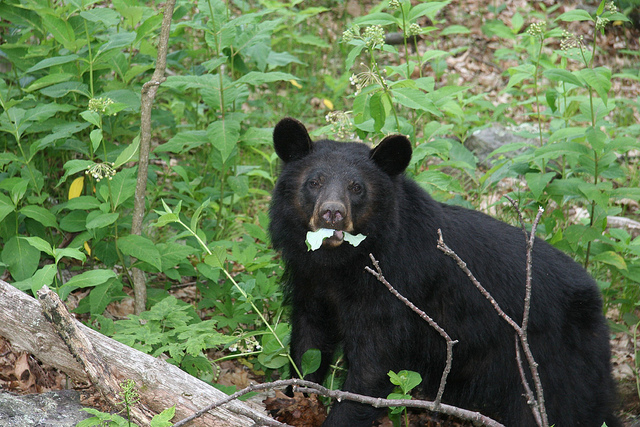You’re on Skyline Drive, taking in the gorgeous scenery on both sides of the road – the Shenandoah Valley to the west, the Virginia Piedmont to the east. Suddenly you see a huge black dog scampering across the road. Wait— that’s not a dog, that’s a bear! All of this happens in a matter of seconds – the bear emerging from the forest onto the pavement, your mind thinking “big black dog,” then all at once realizing “bear!”
The chance to see a black bear in the wild is one of the biggest attractions of Shenandoah National Park. Some people find the experience of spotting a bear great fun. Some find it unnerving. Everyone finds it thrilling.
Biologists estimate that there are between 200 and 1,000 black bears in Shenandoah at any given time. (Black bears are the only bears found in Shenandoah.) That’s a gracious plenty of bears in the 300 square miles that comprise the Park – we’re talking approximately one to four bears per square mile. This means you have a fairly good chance of seeing a black bear while you’re here. No guarantees, of course: some people see a bear on their first visit to Shenandoah, and some return time after time and never see one.
Black bears are most active in the darker hours of the day – dusk and dawn – so being out and about in the early morning and evening ups your chances of seeing a bear. But bears are active during the day, too, and that’s when most sightings occur (which probably has a lot to do with the fact that most people drive and hike in the Park in the daytime). Both Shenandoah visitor centers – Dickey Ridge Visitor Center, at mile 4.6 on Skyline Drive and Byrd Visitor Center at mile 51 – keep wildlife sighting logs, for Park visitors to post where they’ve spotted bears. If you want to see a bear, check out one of the sighting logs to find out where you’ll have the best chances to do so.
If an encounter occurs…
For your safety and bears’ safety, don’t approach bears (or any wildlife) too closely, even though you might be tempted to do so. Black bears are wildlife, which means exactly that: they are wild animals. Although they might look cuddly, they are not. If you see a bear when you’re out hiking or driving, give it a wide berth. If you’re out on a trail, you’ll probably hear a bear before you see it, as bears have an excellent sense of smell and hearing, and, at short distances, their eyesight is keen. Bears usually know you’re around before you ever lay eyes on them, and most of the time they will scurry off to a safe distance to avoid you.
If you don’t want to run across a bear in the wild, consider putting a bell on your pack, chatting with your hiking mates, or even singing. If you see a bear while motoring along Skyline Drive, pull completely off the road to view or photograph it – again, from a safe distance. And never approach a bear cub or young bear. Mama is almost certainly nearby, and she will see you as a threat to her young. When camping, store your food properly.
For tips on bear safety in Shenandoah National Park, visit the Park’s Bear Safety webpage. For tips on finding and photographing bears, check out Shenandoah’s Wildlife Viewing & Photography page.
Happy (and safe) viewing!
